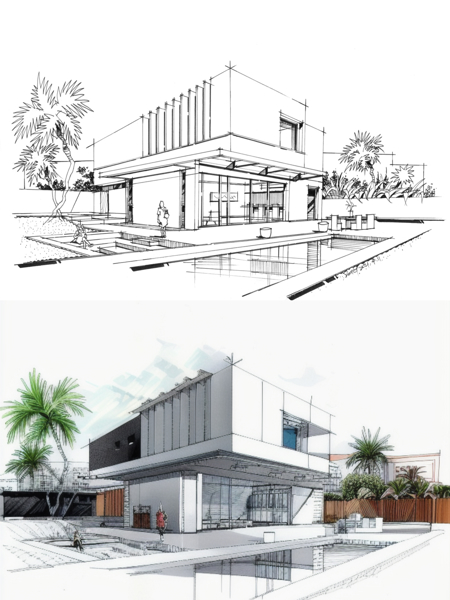Recognizing the Collaborative Refine In Between Designers and Engineers in Modern Construction Projects
The joint process in between architects and designers is important in modern-day building tasks, as it harmonizes style intent with engineering expediency. Discovering these dynamics exposes insights that might dramatically impact job end results and overall market criteria.
The Significance of Cooperation
The collaborative synergy in between engineers and engineers is necessary for the effective realization of any type of building and construction project. This partnership brings with each other distinctive knowledge and viewpoints, making it possible for the integration of ingenious style with sensible design solutions. By interacting, engineers and designers can make certain that a project not only satisfies aesthetic and practical demands yet additionally complies with safety, sustainability, and budgetary constraints.
Partnership promotes a shared vision, assisting in the positioning of objectives and assumptions from the beginning. This positioning is important in addressing potential challenges and mitigating risks that could arise during the task lifecycle. A collective method allows for the efficient appropriation of sources, enhancing both time and expense.
The significance of collaboration encompasses the repetitive procedure of style and construction, where feedback from designers can notify architectural choices, bring about even more possible and sustainable layouts. On the other hand, architects can motivate designers to think artistically concerning exactly how to achieve architectural stability without compromising imaginative intent. Eventually, the collaborative partnership between architects and designers is not merely valuable; it is essential to the creation of high-quality, practical, and innovative constructed atmospheres that fulfill the requirements of culture.
Interaction Techniques and Devices
Effective interaction techniques and tools are vital for promoting collaboration in between architects and engineers throughout the project lifecycle. Establishing clear channels of interaction is necessary to ensure that all employee are lined up with task objectives, timelines, and duties. Regular conferences, both in-person and digital, offer possibilities for stakeholders to discuss development, address problems, and make notified choices.
Making use of project administration software, such as BIM (Building Info Modeling) systems, enhances partnership by making it possible for real-time sharing of design modifications and technological requirements. These tools assist in openness, permitting architects and engineers to picture adjustments and assess their effect on the general job.

Shared Goals and Project Vision

Developing shared objectives involves open discussion and a thorough understanding of each self-control's contributions. Designers typically focus on layout intent, spatial relationships, and customer experience, while engineers highlight architectural integrity, systems performance, and conformity with regulations (cda architects). When these point of views are straightened, the result is a cohesive task that abides by both innovative desires and technological feasibility
Furthermore, a distinct task vision fosters responsibility amongst group members, encouraging each participant to take possession of their duty in attaining the desired result. Routine check-ins and joint workshops can better reinforce this commitment, enabling modifications to be made as the task advances. Inevitably, a shared vision not only enhances teamwork however likewise raises the high quality of the last deliverable, bring about effective task conclusion.
The Duty of Modern Technology
Leveraging modern technology has actually become crucial in improving collaboration in between architects and designers. The combination of innovative software application tools assists in real-time communication and details sharing, enabling groups to work a lot more efficiently and properly. Building Info Modeling (BIM) stands out as a crucial technology, enabling both architects and engineers to develop comprehensive 3D versions that encapsulate style intent and architectural integrity. This shared aesthetic representation lessens misconceptions and improves the decision-making procedure.
Additionally, cloud-based systems make it possible for seamless partnership, enabling task stakeholders to accessibility and update project data from anywhere. This promotes a society of openness and liability, as adjustments can be tracked and reviewed in real-time. Additionally, mobile click here for more applications further enhance communication, offering on-site teams with instant accessibility to job specs and updates.
Arising innovations such as man-made knowledge and artificial intelligence are additionally starting to contribute in anticipating evaluation, assisting teams determine prospective issues before they arise. Ultimately, the duty of modern technology in architecture-engineering cooperation not just enhances process effectiveness but also boosts technology, bring about even more successful project end results. By welcoming these technical developments, architects and designers can make certain a much more cohesive and productive joint procedure throughout the construction lifecycle.
Study in Successful Partnerships
Countless situation research studies illustrate the extensive effect of effective collaborations between engineers and designers on project end results. One significant example is the cooperation on the High Line in New York City, where landscape engineers, designers, and urban organizers worked with review each other to transform a deserted rail line right into a lively public park. This multidisciplinary approach not just enhanced the visual quality yet also made certain structural safety and security and environmental sustainability.
An additional exemplary instance is the design and building and construction of the Sydney Concert Hall. The collaboration between designer JÃ ¸ registered nurse Utzon and structural designer Ove Arup exemplified ingenious analytic. Their collaboration enabled the iconic shell-like style while addressing complicated design challenges, eventually bring about a timeless building work of art.
The Burj Khalifa in Dubai further demonstrates the value of collaborative efforts. cda architects. The assimilation of style and engineering know-how enabled the project team to attain unprecedented heights while adhering to security laws and aesthetic vision
These examples highlight the value of interaction, trust, and shared purposes. In today's intricate construction environment, such partnerships are important to browsing obstacles and supplying projects that meet both functional and visionary goals.
Conclusion
In verdict, the cooperation between architects and designers is crucial for the success of contemporary building projects. Reliable interaction techniques, a next common job vision, and the integration of innovative modern technologies are vital components that promote this partnership.